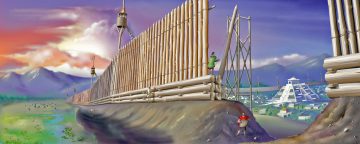
I absolutely love the war chapters in the Book of Mormon! There are so many lessons that can be drawn from Alma 46-62. I’m sure we’ll have many different entries about this portion of the Book of Mormon as we go along.
Today, I want to focus on Alma 50:1-4. We learn that “Moroni did not stop making preparations for war” against the Lamanites. He was constantly preparing himself and his people to stay a step ahead of the Lamanites. In Alma 50, Moroni began fortifying all of the Nephites’ cities in a particular manner to protect them from the Lamanites.
They did four things specifically. First, they dug up heaps of earth round about the cities. Second, on top of these heaps of earth, they built up works of timbers to the height of a man. Third, on top of these works of timbers, they built frames of pickets that were strong and high. And fourth, they erected towers that overlooked those frames of pickets from which guards could see the enemy approaching.
I’ve thought a lot about these fortifications. Individually, we all need to build up spiritual fortifications against the buffetings and temptations of Satan. These four types of fortifications symbolically remind me of things I need to do to protect and strengthen myself spiritually.
First, digging up heaps of earth reminds me of kneeling down on the ground or the earth to pray. The more we get ourselves down on the earth and dig our knees into the ground to pray, the more this fortification will completely encircle us. Prayer is a wonderful protection for all of us, but enemies could still effectively attack us without additional fortifications.
Second, the works of timbers remind me of the scriptures. What do you need to make paper? Timber, of course! The scriptures are a work of timber. Daily feasting upon the scriptures fortifies us against our attackers and their deadly arrows. Still, these works of timbers were only built up to the height of a man. The enemy could still overcome this obstacle with persistence and do some harm.
Third, the frames of pickets remind me of Church steeples and temple spires. We need to be consistent in both our Church and temple attendance to make these frames of pickets strong and high. We make it much less likely for an enemy attack to be successful with these three fortifications in place.
Fourth, the towers that were erected for guards to overlook the works of pickets remind me of the watchmen on the towers we have today, our prophets and apostles. Great safety is promised if we follow their counsel.
Our fortifications are quite strong and secure at this point, leaving only one vulnerability – the place of entrance. This vulnerability is mentioned five times in Alma 49. The only way into our place of security if we have properly fortified ourselves is through the place of entrance. We have to always guard ourselves against what we bring into our mind, eyes, and heart. Satan can get into our place of security through the entrance if we allow. However, if we fortify ourselves through prayer, scripture study, Church and temple attendance, and by following the prophet, the Holy Ghost will strengthen us in our efforts to resist temptations that are aimed directly at our place of entrance.

This was amazing. Thank you for sharing your love of the scriptures and a better way to truly chew into them. And the picture of your son Jack is adorable!!! and one more way to remember “that little child shall lead them” his example of scripture study is a reminder to me that I too can study more effectively and find the time to put away childish things and focus on what matters most. Can’t wait to read your book.
Wow,excellent.. http://wellparraneso.gq Custom Writing Term Paper
Your web site does not render correctly on my apple iphone – you might wanna try and repair that ancnicocixob.ga vilirovara.ga
Выездной шиномонтаж 24/7 – Выездной мотошиномонтаж, Прайс шиномонтаж
Chandigarh, the capital of the northern Indian states of Punjab and Haryana, was designed by the Swiss-French modernist architect, Le Corbusier. His buildings include the Capitol Complex with its High Court, Secretariat and Legislative Assembly, as well as the giant Open Hand Monument. The nearby Rock Garden is a park featuring sculptures made of stones, recycled ceramics and industrial relics.
Chandigart
Chandigarh, the capital of the northern Indian states of Punjab and Haryana, was designed by the Swiss-French modernist architect, Le Corbusier. His buildings include the Capitol Complex with its High Court, Secretariat and Legislative Assembly, as well as the giant Open Hand Monument. The nearby Rock Garden is a park featuring sculptures made of stones, recycled ceramics and industrial relics.